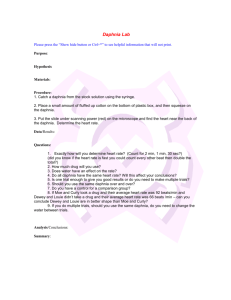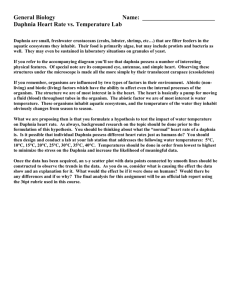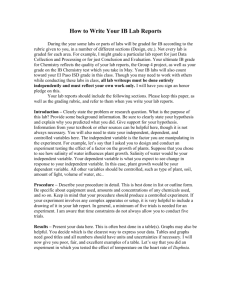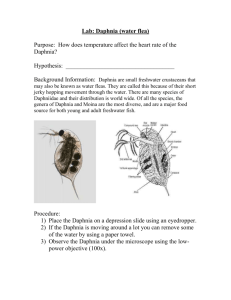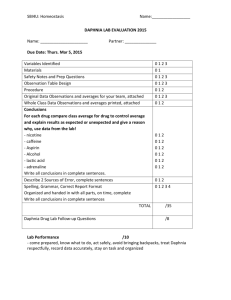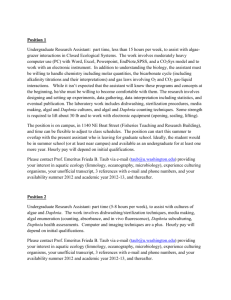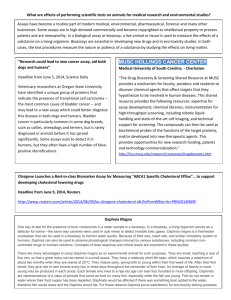File
advertisement
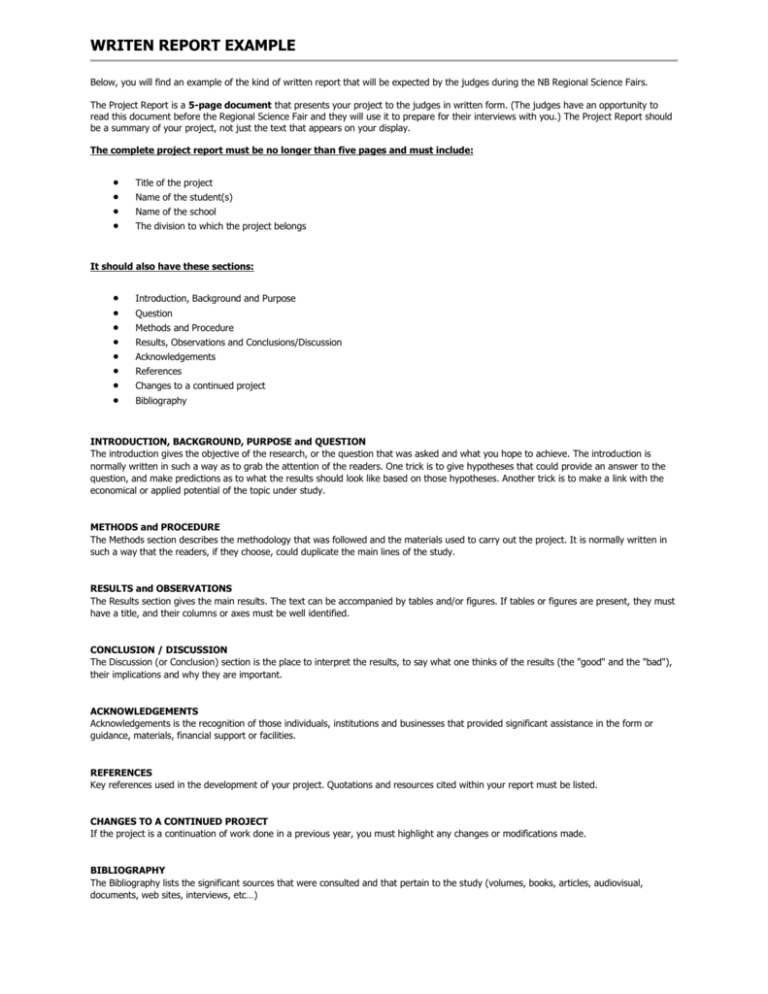
WRITEN REPORT EXAMPLE Below, you will find an example of the kind of written report that will be expected by the judges during the NB Regional Science Fairs. The Project Report is a 5-page document that presents your project to the judges in written form. (The judges have an opportunity to read this document before the Regional Science Fair and they will use it to prepare for their interviews with you.) The Project Report should be a summary of your project, not just the text that appears on your display. The complete project report must be no longer than five pages and must include: Title of the project Name of the student(s) Name of the school The division to which the project belongs It should also have these sections: Introduction, Background and Purpose Question Methods and Procedure Results, Observations and Conclusions/Discussion Acknowledgements References Changes to a continued project Bibliography INTRODUCTION, BACKGROUND, PURPOSE and QUESTION The introduction gives the objective of the research, or the question that was asked and what you hope to achieve. The introduction is normally written in such a way as to grab the attention of the readers. One trick is to give hypotheses that could provide an answer to the question, and make predictions as to what the results should look like based on those hypotheses. Another trick is to make a link with the economical or applied potential of the topic under study. METHODS and PROCEDURE The Methods section describes the methodology that was followed and the materials used to carry out the project. It is normally written in such a way that the readers, if they choose, could duplicate the main lines of the study. RESULTS and OBSERVATIONS The Results section gives the main results. The text can be accompanied by tables and/or figures. If tables or figures are present, they must have a title, and their columns or axes must be well identified. CONCLUSION / DISCUSSION The Discussion (or Conclusion) section is the place to interpret the results, to say what one thinks of the results (the "good" and the "bad"), their implications and why they are important. ACKNOWLEDGEMENTS Acknowledgements is the recognition of those individuals, institutions and businesses that provided significant assistance in the form or guidance, materials, financial support or facilities. REFERENCES Key references used in the development of your project. Quotations and resources cited within your report must be listed. CHANGES TO A CONTINUED PROJECT If the project is a continuation of work done in a previous year, you must highlight any changes or modifications made. BIBLIOGRAPHY The Bibliography lists the significant sources that were consulted and that pertain to the study (volumes, books, articles, audiovisual, documents, web sites, interviews, etc…) EXAMPLE REPORT: Effect of Daphnia swarm density on the attack rate of a predatory fish, the stickleback Mark Myword and Mary Krissmus, PaksakHigh School, Paksak, NB, E7Y 8H6 Division: Life Sciences Introduction For animals, living in groups offer many advantages. One of them is protection against predators. For example, the more individuals there are in a group, the greater the chances of detecting the approach of a predator. Also, the more individual prey there are, the harder it may be for the predator to concentrate on just one and successfully catch it. In the same way that it is difficult for a person to catch a ball when a dozen are thrown at him or her at the same time, it may be confusing for a predator to capture a particular prey when a great number of them are milling about, overtaking one another or moving in all directions. On the other hand, dense groups may be more easy to detect by predators and may therefore draw more attacks upon themselves. Therefore, it is hard to predict whether prey should aggregate in dense groups (maybe more chances of confusing the predator, but also more chances of being detected first) or in less dense ones. It is also unclear what the predator itself should do; go for the dense group because of the great number of prey there, or for the small group because of the ease of catching prey without getting confused. In this experiment, we tested whether the three-spined stickleback, Gasterosteus aculeatus, which is a predator of Daphnia (also called the water flea), prefers to attack big or small groups of its prey. We also calculated the average risk of each Daphnia in groups of different sizes, to establish whether Daphnia should seek to live in large or small groups. Methods In the fall, we captured six three-spined sticklebacks with minnow traps set in a small tidal pool along the PetitcodiacRivernear Moncton. Four were females and two were males. They were kept together in a 40-liter aquarium filled with freshwater. We also obtained Daphnia by filtering water from a freshwater pond. Some of these Daphnia were given to the sticklebacks to get them used to this kind of prey. All tests took place in a separate 40liter aquarium covered with gravel at the bottom and with the water temperature varying between 15 and 18 degrees Celsius. One of the six sticklebacks was placed in this aquarium and given one day to get used to these new surroundings. Then a row of three test tubes was lowered into the aquarium. Each tube was 10 cm long, 2 cm wide, and was separated from its neighbor by 15 cm. One tube contained 40 Daphnia, a second one contained 10 Daphnia, and the last one had 2 Daphnia. We had transferred the Daphnia into the tubes with a pipette. Each tube was stoppered to prevent the Daphnia from escaping. The order in which each of the three tubes was positioned along the row was determined by drawing their number from a hat. From the moment that the stickleback directed its first strike to any one of the tubes, we started counting the number of strikes at each tube for each minute of the next 4 minute period. A strike was designed as a contact of the stickleback's snout to any part of the test tube. We repeated this test with each one of the other sticklebacks, for a total of six fish tested. An average was calculated from these six fish. Results We divided the 4-minute experimental period into two halves. During the first 2 minutes, the sticklebacks directed, on average, 28 attacks at the 40Daphnia group, 19 at the 10-Daphnia group, and 6 at the 2-Daphnia group. During the last 2 minutes, the number of attacks changed to 12, 16, and 34 attacks towards the 40, 10, and 2-Daphnia swarms respectively At all times during the test, the individual risk was lower for Daphnia in the largest group. We therefore conclude that large groups are beneficial to Daphnia, at least when they are under attack by a single stickleback. Whether the same applies to situations with many sticklebacks could be tested future experiments Conclusions The larger a swarm of Daphnia is, the more attractive it seems to be at first for a stickleback. Indeed, during the first two minutes of our tests, the absolute number of attacks was greater for the largest swarm sizes. However, once a stickleback starts to try to feed on Daphnia, its attention seems to shift to the smaller swarms. This is shown by the reverse relationship between attack frequency and swarm size in the last two minutes of the tests. We concluded that sticklebacks detect larger swarms more easily, but that they may try to overcome the confusion effect of large swarms by attacking less dense parts of it, or by switching to less dense groups nearby. At all times during the test the individual risk was lower for Daphnia in the largest group. We therefore conclude that large groups are beneficial to Daphnia, at least when they are under attack by a single stickleback. Whether the same applies to situations with may sticklebacks could be tested in future experiments. Bibliography Grier, J., and Burk, T. 1992. Biology of Animal Behaviour (2nd. ed.). Mosby Year Book, St. Louis. Milinski, M. 1977. Do all members of a swarm suffer the same predation?ZeitschriftFŸr Tierpsychologie 45, 373-388.

